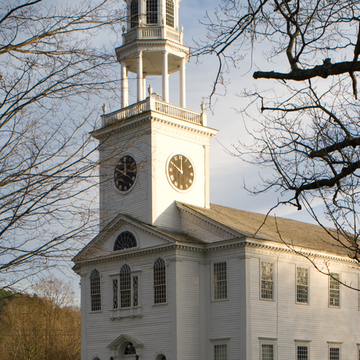The church is centered on the village's triangular green, providing a focus for this once-prosperous farming and milling village. It is not surprising to find that the commissioners of this Charles Bulfinch–type church came from Litchfield County, Connecticut, and Berkshire County, Massachusetts, where they would have undoubtedly known Bulfinch's Pittsfield, Massachusetts, meetinghouse and its significant regional progeny. Nor is it surprising to discover that joiner Elisha Scott, who came to East Poultney from Tolman, Connecticut, to build the church, owned an annotated copy of Asher Benjamin's The Country Builder's Assistant (1797), now a prized possession of the local historical society. The church's massing comes directly from Benjamin's book, as do such details as the Ionic-columned entrance. No mere copyist, Scott moved the lunette of the facade on Benjamin's tower to East Poultney's pediment to make room for a clock. He used a Palladian window with balusters, common in Litchfield County, and placed arched windows to either side of it. His fluted corner pilasters carry an entablature with an elaborate fretwork frieze, which he repeated on the raking cornices, on the lintel boards of the first-story windows, and as the muntin pattern for the sidelights of the Palladian window. In place of Bulfinch's and Benjamin's domes, Scott topped the octagonal lantern above the open belfry with a graceful concave roof cap. The sanctuary was divided horizontally with the addition of a floor at gallery level in 1839. The upper tower, damaged in a 1908 storm, was restored in 1937 by Rutland architect Payson Webber. As was typical in Vermont, the restoration was a gift in memory of a native son who sought his fortune elsewhere—George Jones, cofounder of the New York Times.
As if taking its cue from another native-son-turned-journalist, Horace Greeley, who apprenticed from 1826 to 1830 at the Northern Spectator (95 The Green) and famously declared “Go West, young man,” in the 1850s East Poultney's commerce followed the draw of the slate industry and the railroad westward to Poultney village. Its departure left the East Poultney townscape virtually frozen in time, with its gem of a church set in a predominantly late-eighteenth-and early-nineteenth-century landscape, much of Elisha Scott's making. His Howe-Dewey House (1813; 88 Bird Street) on the west side of the green utilizes details drawn from the church. The Loveridge House (north side of VT 140) mixes a Federal side-hall central block with fanlit door (c. 1818), matchboarded wings (c. 1830), and a pilastered order that anticipated Greek Revival tastes that would emerge full-blown in Poultney village.


